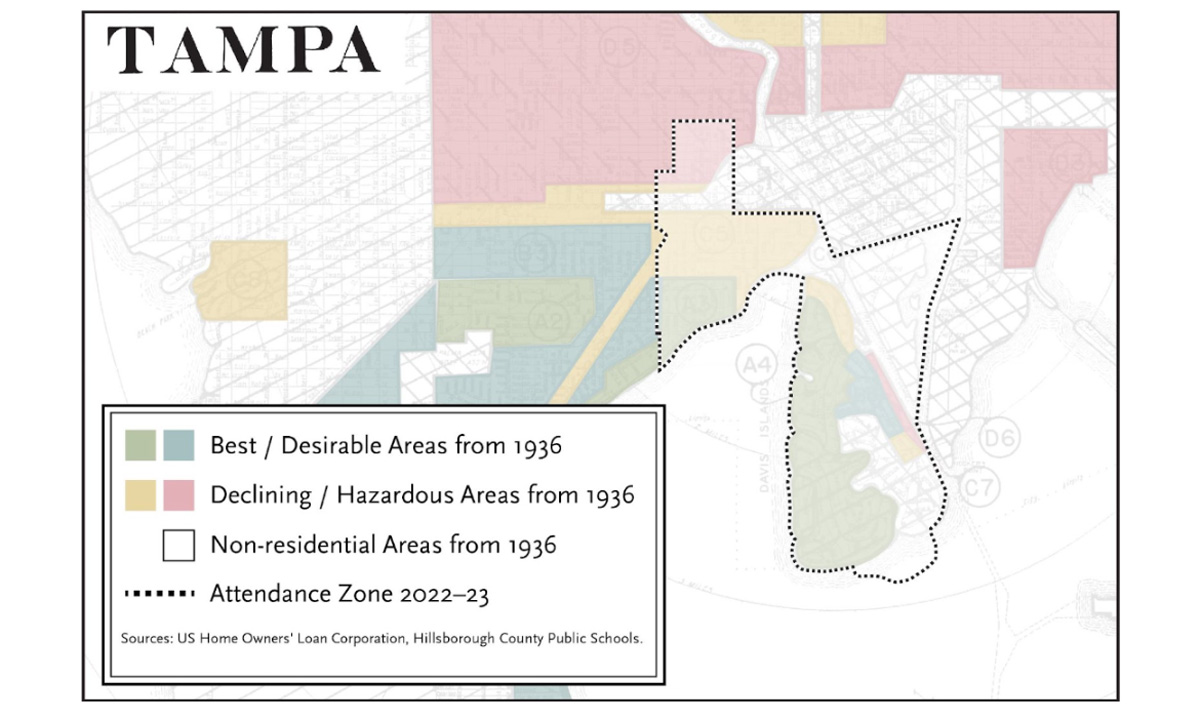Educational Redlining, Rezoning and the Bitter Politics of School Closures
DeRoche: Tampa offers a case study in why shutting a failing school should mean better outcomes for students — but rarely does.

Get stories like these delivered straight to your inbox. Sign up for The 74 Newsletter
When the Tampa school board voted in May to close Just Elementary School, it wasn’t a surprise. Just is the only school in Florida to receive an F from the state Department of Education, and fewer than 11% of its students can read at grade level. It’s already half-empty.
In theory, the closure should have been good news for families whose children attend Just. There’s a great public school, Gorrie Elementary, about 2 miles away. At Gorrie, 80% of the kids read at grade level. For many Just families, Gorrie is much closer to home, so a reassignment there would mean a shorter commute, too.
But that’s not what happened. Like many elite urban elementary schools, Gorrie is full up with families who have crammed into the attendance zone. So the Just students got assigned to Tampa Bay Boulevard and Washington elementary schools, which have reading proficiency levels of 51% and 27%, respectively. For most of these families, their new school is further away than Gorrie.
The outcome was predictable. It is a pattern that plays out in almost all urban American districts.
In 2020, I published a book about educational redlining and the coveted public elementary schools that are protected by attendance zones — places like Lincoln Elementary in Chicago, PS 8 Robert Fulton in Brooklyn, Lakewood Elementary in Dallas and Mount Washington Elementary in Los Angeles.
Gorrie shares all the telltale characteristics of these schools: full enrollment, demographics that skew wealthier and whiter than nearby schools, much higher rates of proficiency on state tests than the district average and homes that cost up to $300,000 more than those just outside the zone because they come with privileged access to a “free” high-quality public education.
My book features maps showing that the attendance zones of many of these schools mirror the racist redlining diagrams drawn during the New Deal era to determine who would (and wouldn’t) qualify for federal housing assistance. If you line up the Gorrie attendance zone with the redlining map of the same neighborhood from 1940, you’ll see that the school zone covers all the areas deemed to be “best” and “desirable” over 80 years ago.
It also boxes out almost all the areas of town that were shaded red and labeled “hazardous” because they had a high concentration of low-income people of color. Those areas are still low-income neighborhoods, and once again those families find themselves on the losing end of discriminatory government maps.
Those maps are not so easy to change.
Earlier this year, before the vote that closed Just Elementary, Superintendent Addison Davis of the Hillsborough County Public Schools released a rezoning plan developed by a high-end New York urban planning firm. His goal was to reduce costs by closing underutilized schools and assigning children to buildings closer to their homes. According to Davis, 44% of Hillsborough schools are underenrolled, while 24% are overenrolled — an imbalance that had contributed to the district’s ongoing financial crisis. The rezoning/closure plan projected capital savings of up to $160 million and annual savings of up to $30 million.
The plan, however, caused a huge public controversy. Many students at Plant High School — an overcrowded, high-performing school that serves many high-income families who live quite far away — would have been assigned to other, closer schools. But their wealthy parents objected, and Davis had to scrap his plans to redo the zone for Plant. The closure of Just Elementary, however, did pass, as there were so few parents left who would object to shutting a failing, half-empty school. Davis has since announced his resignation, perhaps a casualty of the bitter politics of his rezoning effort.
Similar tensions play out in my old neighborhood of Los Angeles. In northeast L.A., seven elementary schools surround coveted Mount Washington. Those seven schools saw average enrollment losses of 66% in the last 15 to 20 years. Meanwhile, Mount Washington saw enrollment increase by almost 40% in a little over a decade. Families have crowded into the Mount Washington zone, pushing housing prices even higher and making access impossible for students of modest means.
Such imbalances cannot go on forever, though. Since coveted schools can accommodate only so many students, and operating half-empty buildings around their perimeter is extremely expensive, districts are eventually forced to do something. Typically, they announce plans to redraw zoning lines. But, as happened with Plant, powerful parents and homeowners object, and school board members make extraordinary concessions to appease them. A number of districts have spent as much as $20 million to renovate a school to add more seats, even though there was a public school just down the road with plenty of room. At Lincoln, Lakewood and Mary Lin Elementary in Atlanta, officials approved millions in wasteful spending just to avoid upsetting parents who had already “paid for” access to a specific public school.
Before he resigned, Davis admitted that he believed part of his job was to ensure that home values continue to go up. Of course, artificially inflated home prices are concentrated in the zones of the most coveted public schools — those protected by educational redlining. It’s astounding that school officials are proud that they contribute to the ongoing housing affordability crisis, which is exacerbated by the persistent use of exclusionary school zones.
Eventually, districts may move away from this archaic model of school assignment, since it violates fundamental American ideals of fairness and undermines the public schools’ noble purpose of providing every child with a fair shot at the American dream. When they do, they should look to the history of the community college system in California. For decades, the system relied on geographic assignment, and enrollment eroded, much as it has in urban K-12 districts.
Then, in 1987, a state commission recommended ending the geography-based system. The legislature agreed and opened up the colleges to all state students. Enrollment rebounded, and now the community college system is one of the most trusted institutions in the state.
School access needn’t be a zero-sum game governed by bitter political fights over maps.
Get stories like these delivered straight to your inbox. Sign up for The 74 Newsletter


